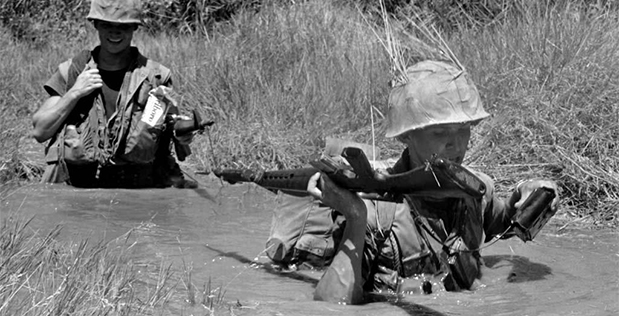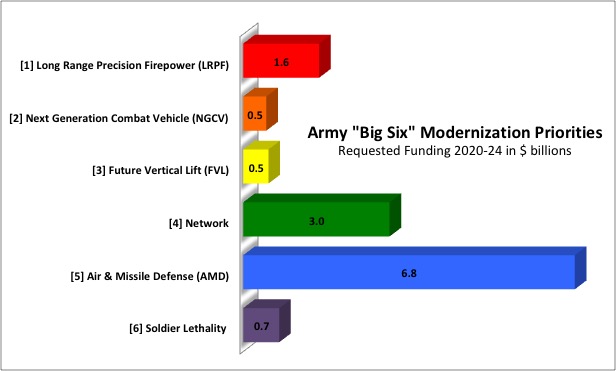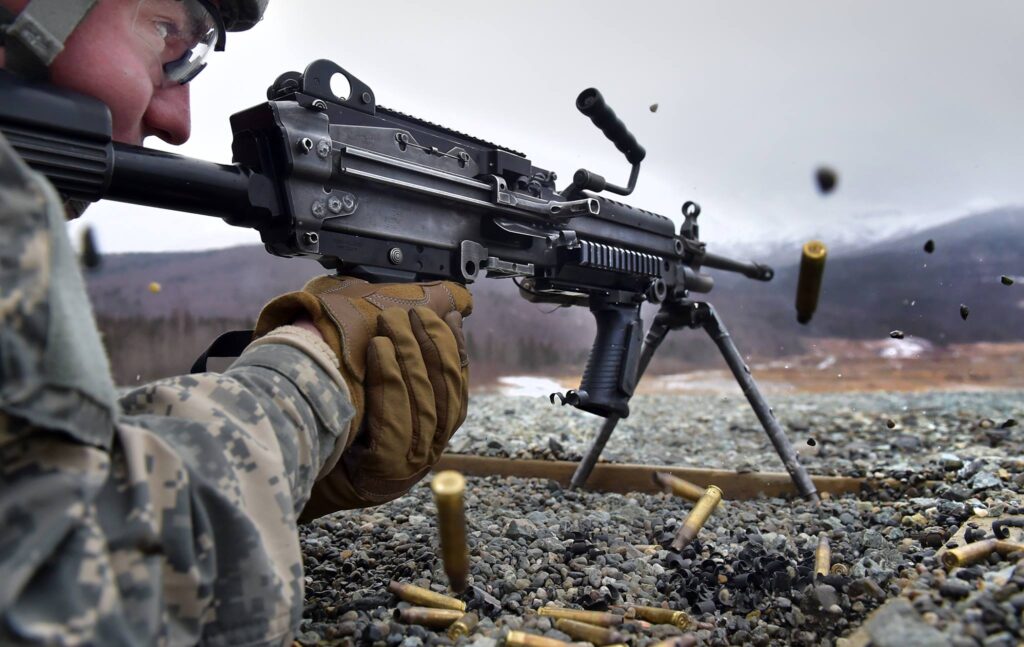Army Moves $25B To Big Six, From New Tanks To 6.8mm Rifle
Posted on
UPDATED with Under Secretary McCarthy comment AUSA: The Army plans to move at least $25 billion over the next five years from low-priority programs to preparing for major war. That includes developing a wide variety of new weapons, many on show here at the Association of the US Army conference, from high-speed aircraft to replace today’s helicopters, to partially-robotic armored vehicles to replace the M2 Bradley, to a long-ranged 6.8 millimeter rifle to replace the venerable M16/M4 family and its controversial 5.56 mm round.
Army Secretary Mark Esper announced the $25 billion figure here in his opening speech to the conference, the largest of the year. The final number awaits approval from the Office of the Secretary of Defense, the White House’s Office Of Management & Budget, and ultimately Congress, Esper cautioned reporters afterwards, but, looking across the 2020-2024 budget plan (aka the FYDP), he said, “that dollar figure is a low end.”
“Most of those savings were principally found in… equipping,” Esper said, what budgeteers call the Equipment PEG (Program Evaluation Group). But “we are in the process now of going through the other PEGs,” he said, such as personnel and facilities, to find similar savings.
The plan is to make such a close scrub of the Army budget a routine, bringing in constituencies from across the service, not just Pentagon bureaucrats. The context — unspoken here at AUSA — is that Budget Control Act caps (aka sequestration) return in 2020. That means the Army can’t count on big increases, forcing them to cut lower-priority programs to fund the Big Six.
UPDATE Based on internal studies of what it would take to develop and field the Big Six, “we needed to find, through reform, upwards of two or three, even five billion dollars in the out years,”Under Secretary Ryan McCarthy told reporters at a roundtable this afternoon. “f you’re blessed with increases in budgets, that’s great. But what we’ve been talking about consistently as a leadership team is, we will take the actions necessary to finance our priorities.”
McCarthy, like Esper, declined to give any details of the budget proposal now under review by the Office of the Secretary of Defense, a process the undersecretary expected will take through Christmas. (As McCarthy has told us before, his Christmases tend to be hectic).
But a range of our sources have told us to study a Bloomberg article from late September, which said the Army was proposing to move $31.6 billion out of upgrades for programs such as the M2 Bradley and its newest variant, the AMPV armored utility vehicle; the CH-47 Chinook helicopter; and the 1980s-vintage ATACMS missile — which is much shorter-range than the new LRPF missiles under study — to plus up funding for the Next Generation Combat Vehicle and Future Vertical Lift aircraft.
Show Me The Money
Undersecretary McCarthy walked the vast show floor here at AUSA this morning and will do so again tomorrow and Wednesday, he told reporters. “One of the things that’s very encouraging that I saw was the behaviors of the companies and what they’re starting to invest,” he said. “Industry is flush with cash right now. (The Army must) encourage them to invest.” And it’s having some success already.
Just walking the floor ourselves this morning, for example, we saw three full-scale, drivable concept vehicles for the Army’s Next Generation Combat Vehicle, all of them very different:
- BAE, which makes the M2 Bradley, offered the latest model of its CV90, widely fielded in Europe (click here for our video tour);
- General Dynamics, which makes the M1 Abrams, offered the third iteration of its Griffin high-tech demonstrator, a distant descendant of the British Ajax (click here for our video tour); and
- Raytheon — which historically doesn’t make vehicles — partnered with Germany’s Rheinmetall to offer an all-new design they’re calling Lynx (click here for our video tour).
The vehicles vary widely in their level of technological maturity versus ambition, as well as specs like weight, horsepower, armament, and troop-carrying capacity. But all represent major investments by major companies of their own money. Likewise, Bell and Sikorsky (part of Lockheed) continue to invest heavily in high-speed, vertical-take-off-and-landing aircraft. (Click here for past coverage of this Future Vertical Lift effort).
“When we’re clear about our priorities and then they see the behaviors of the leadership team putting the funding against ’18, the funding against ’19, the actions we’re taking against ’20, we’re very clear ot the marketplace about what we want,” McCarthy said. “if we can have conviction behind that and can stick with it, industry can come meet you partway.UPDATE ENDS
The Big Six
In their review of the equipment portfolio, Esper said, he and the Army Chief of Staff, Gen. Mark Milley, spent some 60 hours “going thru program after program, activity after activity, looking at each one assessing and asking ourselves: “Is this more important than the Next Generation Combat Vehicle? is this more important than a new squad automatic weapon? Is this more important than Long-Range Precision Fires?”
Those examples hit three of the Army’s Big Six modernization priorities, which are — in order of importance — long-range precision fires, aka missiles; new armored vehicles; new aircraft; upgraded networks that can withstand jamming and hacking; improved anti-aircraft and missile defense; and, lastly, individual equipment.
But while individual “soldier lethality” may be the last of the Big Six, it still outranks everything else in the Army. And because soldier kit is relatively small and simple, it’s actually the first of the Big Six to actually field new equipment. That includes a fighter-pilot-style HUD (Heads Up Display) for infantry soldiers, using augmented reality technology that lets them train against virtual opponents on real terrain (like Pokémon Go with guns) or see tactical data in combat without ever taking their eyes off the threat. But the soldier lethality portfolio also includes replacing the venerable M16 rifle and its derivatives, whose finicky mechanisms and small 5.56 mm bullet have caused bitter controversy.
Shooting For 6.8
“We’re committed to a new rifle and a new squad automatic weapon,” Gen. Milley told reporters this morning “Right now, feedback looks like we’re going to go to a 6.8 caliber round.” That’s a lot heftier than the M16/M4 family’s 5.56 round — derided as “varmint round” because it’s nigh-identical to the civilian .223 caliber — but a lot lighter than the 7.62 round used by the M14 rifle, used early in Vietnam and still prized by marskmen. The tradeoff is that heavier rounds go farther and hit harder, which is particularly important with the worldwide spread of body armor, but they also have more recoil, which hurts accuracy, and weigh more, whch liits the reloads a soldier can carry.
But the new weapon is not just about a new caliber, Milley made clear.
“What I’ve seen so far,” the Chief of Staff said, “(and) this is entirely technologically possible, (is) an accurate range far in excess of any existing known military rifle today.”
“It will fire at speeds that far exceed the velocity of bullets today,” Milley continued, “and it will penetrate any existing… body armor” — or any future body armor projected to be fielded “in the next quarter century.”
The Army’s already seen multiple prototypes, Milley said, and will conduct test firing on ranges next year. The first phase of this effort is the Next Generation Squad Weapon (NGSW), which will replace the M249 SAW, a 5.56 mm light machinegun issued one or two per 10-man squad. The second will be a new Squad Automatic Rifle to replace the M16 and M4 — but only for frontline combat troops like infantry, special operations, and combat engineers. That’s about 100,000 people: The vast majority of the Army, nearly 900,000 active, Guard, and Reserve soldiers, will stick with the M4 and M16.
“We expect it to be expensive,” Milley said of the future weapon. But after years of favoring sexier technical specialties, the US Army is increasingly mindful of its grunt infantry, who do most of the dying in wars ancient and modern. That focus is driving new investments in infantry training — recently increased from 14 weeks to 22, with the ratio of drill instructors to recruits set to double — and technology. So while soldier gear is the last and least of the Big Six priorities, it’s still big enough to make things happen, and soon.
Subscribe to our newsletter
Promotions, new products and sales. Directly to your inbox.






